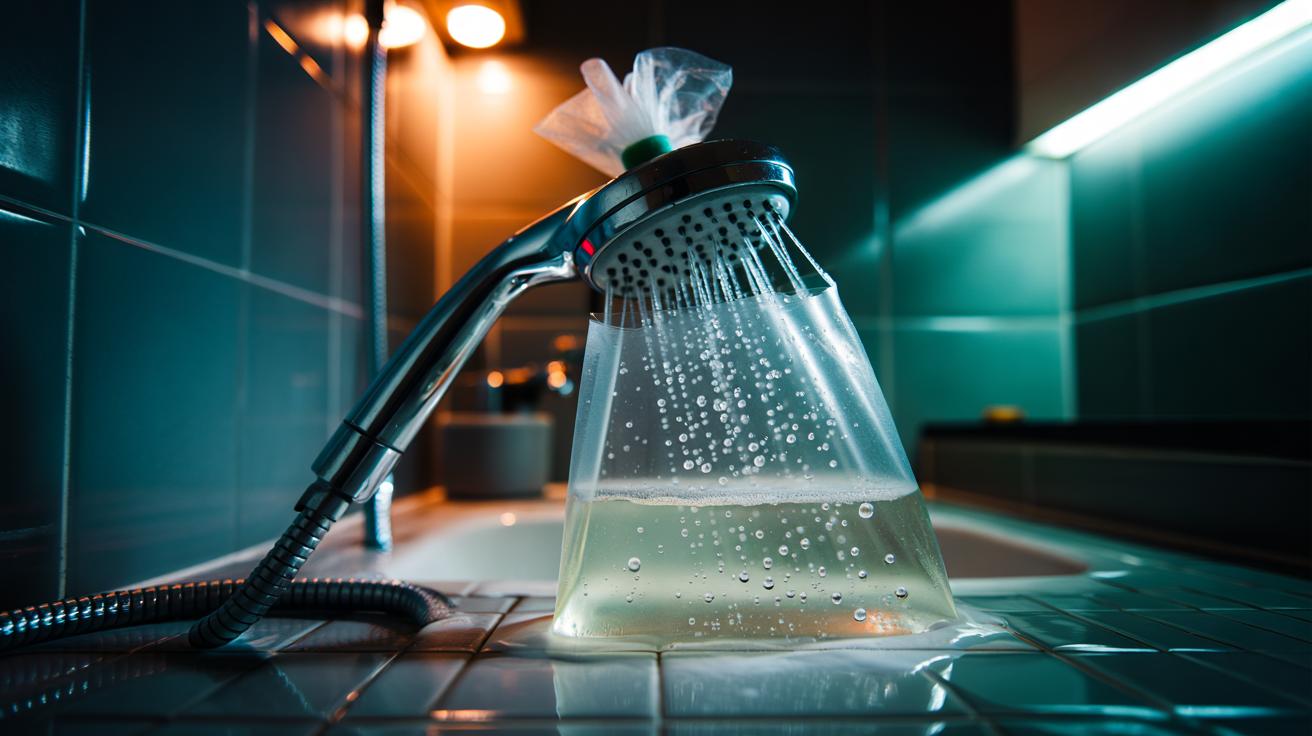In a nutshell
- 🧪 Why it works: Vinegar’s acetic acid reacts with limescale (calcium carbonate) to form soluble calcium acetate, releasing fizzing CO₂ and freeing blocked jets.
- 🛁 Plastic bag method: Fill a sturdy bag with white distilled vinegar (neat or 1:1), secure over the showerhead, soak for 6–12 hours, then brush, massage rubber nozzles, and flush hot water.
- 🧼 Safety first: Never mix vinegar with bleach; ventilate, protect eyes/skin, and support the bag’s weight. Spot-test delicate finishes like brass, gold plate, or old nickel.
- 🧱 Surface care: Keep acid off marble and limestone; mask nearby stone and grout. Use shorter, repeated soaks for very heavy deposits or consider part removal for deep cleaning.
- 🌿 Maintenance gains: Adopt a monthly mini-soak, wipe the head dry after showers, and enjoy restored pressure and spray patterns without harsh chemicals or high costs.
Hard water leaves its mark on British bathrooms, turning once-sparkling showerheads drab with chalky crust. That crust is limescale, and it robs your shower of pressure, spoils spray patterns, and leaves streaks on tiles. The simplest fix is hiding in your pantry. The so-called vinegar and plastic bag trick uses everyday white vinegar to dissolve deposits while you sleep. Secure a bag of vinegar over the head, leave it overnight, and wake to a free-flowing spray. It costs pennies, avoids harsh fumes, and works on most finishes when you take a few sensible precautions. Here’s the science, the method, and the pitfalls to avoid.
Why Vinegar Works on Limescale
Limescale is primarily calcium carbonate, the insoluble mineral that forms when hard-water calcium meets heat and air. Household vinegar contains around 5% acetic acid, which reacts with calcium carbonate to create soluble calcium acetate, water, and bubbles of carbon dioxide. That fizzing is your signal the chemistry is underway. The gentle acid loosens crystalline deposits so they rinse away without aggressive scraping. Unlike many proprietary descalers, white vinegar leaves no scented residue and doesn’t attack most modern chrome-plated surfaces when used briefly and rinsed well.
There are limits. Old nickel, unlacquered brass, or cheap coatings can be fragile, and natural stone is sensitive to acids. That’s why spot-testing on a hidden edge is essential before a full soak. The attraction of vinegar is control: you dictate dilution, duration, and coverage. When used sensibly, it restores blocked nozzles and improves flow, often revealing that a “weak boiler” was simply a scaled showerhead all along.
The Plastic Bag Method, Step by Step
First, gather a sturdy food bag, elastic band or zip tie, and enough white vinegar to submerge the spray plate. For typical chrome heads, use vinegar neat for heavy scale or dilute 1:1 with water for delicate finishes. Fill the bag halfway, lift it to envelop the showerhead, and secure the neck tightly so the nozzles are underwater but the fitting isn’t strained. Check for drips. If the head is removable, you can detach it and soak the face in a bowl instead—simpler, with less chance of splashing.
Leave the bag in place for 6–12 hours; overnight suits stubborn deposits. In the morning, remove the bag, pour away the vinegar, and gently scrub with a soft brush or old toothbrush to dislodge softened scale. Run hot water for a minute to flush loosened particles from the jets and hose. For rubber nozzles, massage each nub with your fingers to pop out residues. Finish by wiping the face with a microfibre cloth and, if desired, a drop of washing-up liquid to cut any remaining film.
| Component | Recommendation | Notes |
|---|---|---|
| Vinegar type | White distilled | Avoid malt or coloured vinegars to prevent staining. |
| Dilution | Neat or 1:1 with water | Use 1:1 on delicate finishes or light scale. |
| Soak time | 6–12 hours | Overnight gives best results on heavy buildup. |
| Bag and fixing | Sturdy bag + elastic band | Support the weight to protect pipework. |
| Aftercare | Rinse and brush | Flush jets; polish with microfibre. |
Safety, Surfaces, and When Not to Use
Acids and bleach are enemies. Never mix vinegar with bleach or bleach-based cleaners: the reaction releases dangerous chlorinated gases. Ventilate the room, protect eyes and skin from splashes, and keep the bag secure so it can’t slip. On finishes such as raw brass, gold plate, or old nickel, reduce time and dilute. If your bathroom features limestone or marble, keep vinegar away from tiles and grout; mask with a damp cloth or plastic wrap before you begin. A little preparation protects pricey surfaces while the acid does its work.
If the head is severely pitted or the cartridge is clogged, chemical cleaning won’t cure mechanical wear. In those cases, remove the showerhead and soak individual parts, or replace worn components like flow restrictors and aerators. If the scale is thicker than a coin, do two shorter soaks instead of one marathon session. For fixed rain heads with minimal clearance, a detachable bowl soak or a proprietary gel descale may be more practical than balancing a sloshing bag overhead.
Vinegar’s real genius is convenience: an overnight acid bath that quietly dissolves limescale while you sleep. Once your shower is restored, slow future buildup by wiping the head dry after use and running a quick monthly mini-soak. That small habit keeps jets clear and spray patterns crisp, saving water and energy in homes battling Britain’s hard-water reality. A simple plastic bag and pantry vinegar deliver a professional-looking clean without professional prices. What’s your next test—will you tackle the kettle spout, the tap aerators, or the glass screen with the same low-cost chemistry?
Did you like it?4.7/5 (21)
